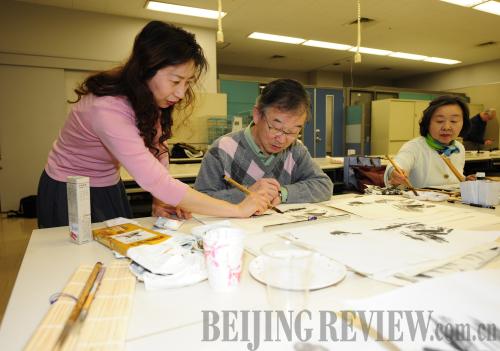|

On August 28, the third China-Japan high-level economic dialogue was held in Beijing. Chinese Vice Premier Wang Qishan and Japanese Foreign Minister Katsuya Okada co-chaired the dialogue. The two sides discussed promoting the economic recovery, as well as regional and global cooperation, and reached a series of agreements.
Post-crisis changes
Unlike the two previous dialogues, held in 2007 and 2009 respectively, the latest dialogue came after the worst of the global financial crisis.
Globally, major economies are recovering. But despite signs of recovery, uncertainties still exist. In the United States, weak investment and a huge trade deficit resulted in a second-quarter annual growth rate of 1.6 percent, far below the target. Also, austerity measures adopted by euro-zone states to address the impact of the Greek debt crisis slowed the recovery of the European economy.
 |
|
LEARNING CHINESE PAINTING: Chinese painting teacher Zhang Xiaowen guides her Japanese students in practicing traditional Chinese painting at the Confucius Institute at Kogakuin University in Tokyo on April 8 | Japan's economy was even worse. The government, which was deeply indebted, could not afford the child-rearing allowance the Democratic Party of Japan (DPJ) had promised in its election campaign. Currently, discussions on whether to reduce the allowance are underway.
The Japanese economy remains weak, and is falling far short of expected growth rates. From January to March 2010, Japan's GDP grew 1.1 percent, year on year. From April to June, the growth rate dropped to 0.1 percent. With the dramatic appreciation of the yen, Japan's exports will experience a setback. Inevitably, the Japanese economy will suffer a further blow, and maybe even a second recession.
Domestic political instability added to the difficulties. Within the DPJ, the fraction led by Ichiro Ozawa and the cabinet team led by Naoto Kan battled fiercely.
In addition, Japan is running out of ideas to rescue its economy. Neither the economically experienced Liberal Democratic Party nor the ruling DPJ—or the financial and academic circles that often set the tone for Japanese economic policies—have been able to come up with solutions to save the Japanese economy. Prospects for economic growth are extremely dim in Japan.
While the world economy is slowly recovering, the Chinese economy is maintaining its growth momentum. According to data released by China's National Bureau of Statistics, in the first half of 2010, China's GDP reached 17.284 trillion yuan ($2.54 trillion), up 11.1 percent from the same period last year.
Although there are obstacles to China's economic growth—including the real estate bubble and environmental pollution—China remains a major market for other economies. With its huge market size, rapid growth and long-term potential, it is set to play a crucial role in helping its neighbors, as well as other global powers, escape the economic crisis.
Economic interdependence
China and Japan held their third high-level economic dialogue against the backdrop of deepening economic interdependence between the two countries.
According to Japanese estimates, China is poised to overtake Japan as the world's second largest economy in 2010, after its GDP in the second quarter of this year surpassed that of Japan. Statistics from the Japan External Trade Organization show the two countries' trade volume reached $138.37 billion in the first half of 2010, up 34.5 percent from the same period last year.
If Japan's trade relationships with China and the United States are compared, it is clear China has cemented its status as Japan's biggest economic and trade partner, and is widening the gap (see table).
Since the beginning of this year, Japan's exports of construction and mining machinery and parts to China have increased 2.2 times, and automobile exports have increased 2.5 times. This is due, in large part, to the Chinese Government's economic stimulus policies. Stimulated by the World Expo in Shanghai, Japan's digital camera and digital video camera exports to China have also increased dramatically.
This has all helped boost the sluggish Japanese industry. Bilateral trade between China and Japan has surpassed the pre-crisis level.
In addition to import and export volume, Japanese companies' production and sales in China will also soon surpass that in the United States. In the first quarter of this year, the total sales volume of branches of Japanese companies in North America was $58 billion, but in the Chinese mainland and Hong Kong, this number was $42.2 billion. And in the first quarter of 2010, the number of employees of Japanese companies in China exceeded 1.18 million, up 7.5 percent from the previous quarter.
Weak domestic demand has led to a reliance on exports, and trade with China accounts for about one fifth of Japan's total trade volume. Japan expects to emerge from its economic difficulties through strengthened relations with China, its biggest trade partner.
In Japan, the government and the business and academic communities have no jealousy toward China's development. Instead, Japan regards China's economic development as an opportunity. Both the government and the business community want to utilize this opportunity to identify a road to the recovery and revitalization of the Japanese economy.
China also has a strong dependence on the Japanese economy. This dependence is most obvious in environmental protection, energy, healthcare and manufacturing, where Japanese technology and management are much more advanced.
Moreover, China's extensive economic growth is largely based on increased resource consumption, and its per-capita GDP is much lower than that of Japan.
China is motivated to learn from advanced economies like Japan, the United States and the EU. It is willing to cooperate with them in a wide range of areas and hopes to have the respect of these developed countries.
| 